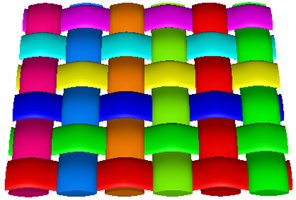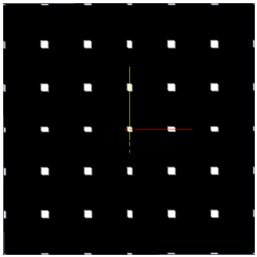Other applications
Surface quality of textile composites
Surface quality is an area which has sometimes placed limitations on the use of polymer composite materials, especially in highly visual applications such as automotive and sporting goods. Initial simulations on the surface quality of polymer composite laminates were examined with the aid of TexGen’s geometric modelling capabilities [1]. This was based on recent research which had been undertaken to experimentally determine the parameters that affect surface quality for polymer composite materials [2]. This work has led to the development of guidelines for acceptable ‘Class A’ surface finish. Experimental work based on statistically robust test methods indicated that the surface roughness is a function of textile architecture and matrix shrinkage. Dominant identified features affecting surface quality included tow size, thermal expansion and chemical resin shrinkage during cure.
TexGen software provided the platform for the development of a surface roughness simulation tool which accounted for textile architecture and specific cure kinetics of the matrix. The study focused on the influence of thermal and chemical shrinkage during cure and localised variation in volume fraction across the surface of a unit cell. A one-dimensional analysis was used to determine proportional dimensional changes to the matrix region, with the results stitched together to form a three-dimensional topological plot. The models were analysed with low and high shrink resin properties. Optical microscopy was used to determine accurate tow forms for compacted tows which aided the development of the geometric model. Simulated profiles, topography and surface roughness measures were compared to experimental data which demonstrated the significance of matrix contraction and fabric architecture on the final surface quality. The simulations were shown to represent experimental data typically to within 6%.
Light transmission through textiles
Due to the attenuation caused by the reinforcement textile and the exponential decay of the light intensity with the depth of penetration, ultraviolet (UV) curing of laminates with a typical thickness of several millimetres is much more challenging than the cure of thin resin films. The capability of TexGen to model fabrics with arbitrary architecture geometrically, implying local non-uniformities on meso- and macro-scale, and multi-layer textile structures, can be used to quantify the UV transmission through reinforcement textiles. The results can be used to predict the UV curing behaviour of laminates incorporating these fabrics.
The example of a single layer of a plain weave glass fibre fabric is illustrated in Figure A for a patch of 3×3 unit cells [3]. The fabric plane is divided into a two-dimensional grid of 100×100 square elements. As described by Wong et al. [4], TexGen can be used to determine the thickness of each material component (voids/resin or fibre) along a pre-defined direction for each element. Projection of the attenuation-weighted local material thickness on the grid along the direction of incident light allows the local transmission to be determined. In case 1 (Figure B), which represents a dry fabric allowing transmission only through the voids between the fibre bundles, the distribution of the transmitted irradiance is determined by the fabric meso-structure. In case 2 (Figure C), where the reflection at the wetted fibre bundles is assumed to be zero, the transmission depends on the micro-structure, which determines the local thickness of the fibre bundles, as well.
References
- ↑ P.J. Schubel, N.A. Warrior, and C.D. Rudd, "Surface roughness modelling of textile composites using TexGen", Proceedings of the 8th International Conference on Textile Composites (TexComp 8), 16-18th Oct 2006, Nottingham, UK.
- ↑ P.J. Schubel, N.A. Warrior, K.N. Kendall, and C.D. Rudd, "Characterisation of Thermoset Laminates for Cosmetic Automotive Applications: Part I - Surface Characterisation", Composites: Part A, 37(10), pp. 1734-1746, 2006.
- ↑ A. Endruweit, W. Ruijter, M.S. Johnson and A.C. Long, "Transmission of UV light through reinforcement fabrics and its effect on UV curing of composite laminates", Polymer Composites (in press).
- ↑ C.C. Wong, A.C. Long, M. Sherburn, F. Robitaille, P. Harrison and C.D. Rudd, "Comparisons of novel and efficient approaches for permeability prediction based on the fabric architecture", Composites: Part A, 37, pp. 847-857, 2006.

